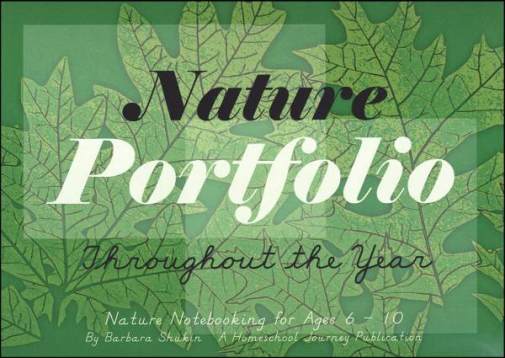We use cookies to make your experience better. To comply with the new e-Privacy directive, we need to ask for your consent to set the cookies. Learn more.
Nature Portfolio: Throughout the Year
Barbara Shukin, creator of the History Portfolios, has assembled another delightful notebooking study, this time a nature study organized by the seasons of the year. Inside the sturdy binder you'll find student notebooking pages, notebooking materials and a parent guide. The pages are divided into three-month blocks: September, October and November; December, January and February; March, April and May; and June, July and August (yes, you can do nature study year-round!). Within each three-month block, there are five habitats, each with three subjects to study. The habitats include yards and gardens, woods and fields, ponds and streams, desert, and seashore. So, for example, in March, April and May you would study frogs, dragonflies and wild flowers in the "Ponds and Streams" habitat. There are 48 notebooking pages in all, with at least one facing two-page spread for each group of three subjects in a habitat. To use this as a year-long nature study you would need to complete 1-2 notebooking pages per week. Now before you jump in, there is just a bit of organization you will need to do. First you need to locate your resources for reading about the nature topics. A very helpful reading guide is included at the very end of the binder to aid you. This includes a detailed chart divided by season, habitat and subject, with recommended readings noted from Handbook of Nature Study, Take-Along Guides, Wonders of Nature Sketchbook, and other recommended picture books and readers. Although you can enjoy the course just as much by utilizing any other resources of your choosing, the author recommends these three resources in particular which you will be able to use throughout the study. You will also need to look at the parent guide pages and decide which activities you will want to complete from the list suggested, and if you need to make copies of any reproducible forms. Activity suggestions include ideas for observation of the subject, copywork from related writings on the topic, narrations based on the reading material you have chosen, classifying the topic by answering questions based on physical characteristics, and learning related vocabulary. When you have gathered your resources, it's time to have fun. You'll read about the topics, go outdoors and observe firsthand, then fill in the sturdy notebooking pages with the activities that you chose. The suggested activities, pictures and forms are recommendations, but you may also come up with your own ideas to fill in the blank areas on the notebooking pages. At the end of each season, you'll find a coloring page and a decorative page for copywork. Poems of the appropriate length are included in the parent's section if you choose to use them. I can't imagine a cozier, more open-ended way to study nature than spending a year with the Nature Portfolio. I love that the chosen nature topics are all common creatures that should be fairly easy to observe, and the study is very open-ended as far as how you fill the pages. The resources the author recommends will be a joy to read together as well. Jess
| Product Format: | Ring Bound Book |
|---|---|
| Brand: | History Portfolio |
| Author: | Barbara Shukin |
| Grades: | 1-5 |
| ISBN: | 9780976291886 |
| Length in Inches: | 9 |
| Width in Inches: | 13 |
| Height in Inches: | 1.75 |
| Weight in Pounds: | 2.4 |

